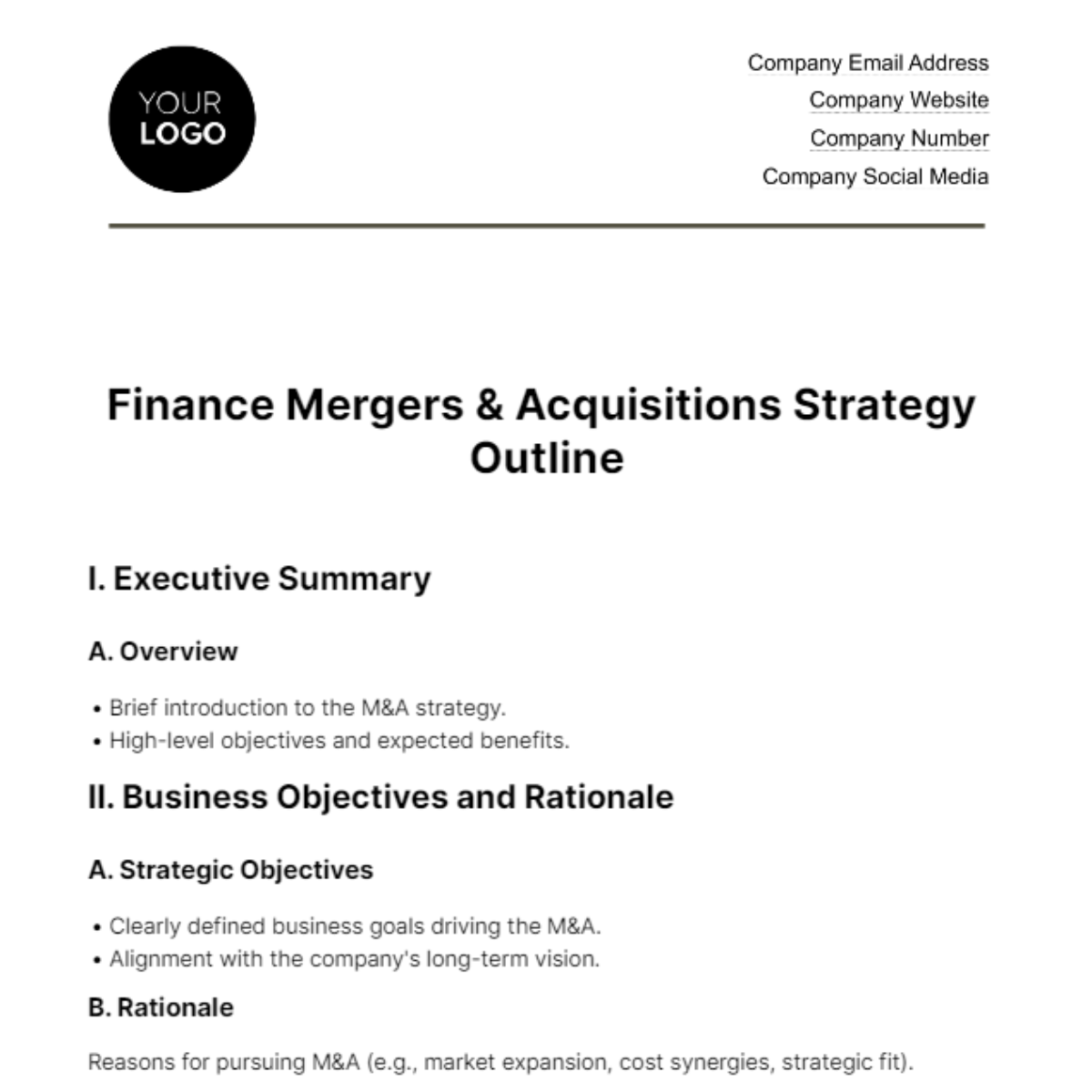Free Finance Mergers & Acquisitions Strategy Outline

I. Executive Summary
A. Overview
Brief introduction to the M&A strategy.
High-level objectives and expected benefits.
II. Business Objectives and Rationale
A. Strategic Objectives
Clearly defined business goals driving the M&A.
Alignment with the company's long-term vision.
B. Rationale
Reasons for pursuing M&A (e.g., market expansion, cost synergies, strategic fit).
III. Strategic Fit and Alignment
A. Target Identification
Criteria for evaluating potential targets.
Assessment of how targets align with strategic goals.
B. Products and Services Alignment
Evaluation of how target's products and services complement existing offerings.
Potential synergies in the product or service portfolio.
IV. Financial Analysis
A. Target Financials
In-depth analysis of historical and projected financial performance.
Valuation methodologies and considerations.
B. Financial Synergies
Identification and assessment of potential financial synergies.
Analysis of cost-saving opportunities.
V. Due Diligence Plan
A. Legal Due Diligence
Legal considerations, compliance, and potential risks.
Engagement with legal experts and due diligence timeline.
B. Financial Due Diligence
Detailed financial scrutiny of the target.
Verification of financial statements and metrics.
C. Operational Due Diligence
Assessment of operational capabilities and challenges.
Identification of integration opportunities.
VI. Integration Plan
A. Cultural Integration
Strategies for fostering a cohesive organizational culture.
Employee engagement and communication plans.
B. Technological Integration
Plan for integrating technology systems and infrastructure.
Minimization of disruptions to operations.
VII. Regulatory and Legal Considerations
A. Compliance
Identification of regulatory requirements.
Strategies for ensuring compliance with antitrust laws.
VIII. Communication and Stakeholder Management
A. Internal Communication
Communication plan for employees, addressing concerns and expectations.
Employee transition and retention strategies.
B. External Communication
Communication plan for customers, suppliers, and investors.
Managing external perceptions and maintaining the company's image.
IX. Financing and Capital Structure
A. Financing Structure
Determination of the financing mix (cash, stock, debt).
Assessment of impact on the company's capital structure.
X. Risk Management
A. Risk Identification
Identification and assessment of potential risks.
Strategies for mitigating and managing risks.
XI. Post-Merger Evaluation
A. Key Performance Indicators (KPIs)
Establishment of KPIs to measure M&A success.
Ongoing monitoring and assessment of integration progress.
XII. Contingency Planning
A. Scenario Analysis
Identification of potential challenges and roadblocks.
Contingency plans for addressing unforeseen circumstances.
XIII. Timeline and Milestones
A. Project Timeline
Creation of a detailed timeline with key milestones.
Structured approach to ensure timely execution.
XIV. Legal and Financial Advisors
A. Advisory Team
Identification and engagement of legal and financial advisors.
Collaborative approach with external experts.
XV. Governance and Decision-Making
A. Decision-Making Structure
Definition of governance structure for M&A decision-making.
Roles and responsibilities of key decision-makers.
- 100% Customizable, free editor
- Access 1 Million+ Templates, photo’s & graphics
- Download or share as a template
- Click and replace photos, graphics, text, backgrounds
- Resize, crop, AI write & more
- Access advanced editor
Unlock strategic excellence with the Finance Mergers & Acquisitions Strategy Outline Template from Template.net. This editable and customizable template, powered by an advanced AI Editor Tool, empowers Chief Strategy Officers to craft comprehensive M&A blueprints. Seamlessly merge financial prowess with strategic vision, ensuring a smooth journey from identification to post-merger success. Elevate your M&A strategy effortlessly.





























